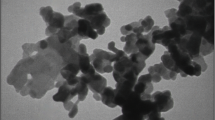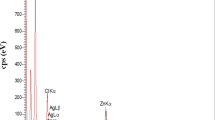Abstract
The recent focus and development of nanotechnology in medicine is countless, which involves diagnostic, therapeutic and preventive systems for various diseases. Nanoparticles have received much attention due to their uses in cancer therapy. The current study focused on the synthesis of baicalein loaded iron oxide nanoparticles and their efficacy against triple negative breast cancer (TNBC) MDA-MB-231. The electron microscopic analysis reveals that the particles were internalized with the various sub cellular regions of selected cancer cells. Further flow cytometric analysis of mitochondrial membrane potential using JC-1 staining showed that significant aggregates were found in the cells treated with baicalein loaded iron oxide nanoparticles, which, in turn, implies momentous mitochondrial membrane potential loss that occurs. Similarly apoptotic and anti-apoptotic gene expression pattern showed that baicalein loaded iron oxide nanoparticles were upregulates the apoptotic genes like Bad, Bax, GADD45 and PARP cleavage in a dose dependant manner. Detailed kit based flowcytometric analysis also reveals that the above findings were significant in the focused field, it is apparent that nano conjugates have the ability to induce apoptosis, DNA damage and cell cycle arrest and decrease the rate of cell proliferation in TNBC cells.






Similar content being viewed by others
References
N. Abu, M. A. Akhtar, K. S. Yeap, K. L. Lim, W. Y. Ho, A. J. Zulfadli, A. R. Omar, M. R. Sulaiman, M. P. Abdullah, and N. B. Alitheen (2014). Flavokawain A induces apoptosis in MCF-7 and MDA-MB-231 and inhibits the metastatic process in vitro. PLoS one, 9, e105244.
M. Ahamed, M. J. Akhtar, H. A. Alhadlaq, and A. Alshamsan (2016). Copper ferrite nanoparticle-induced cytotoxicity and oxidative stress in human breast cancer MCF-7 cells. Colloids Surf. B Biointerfaces 142, 46–54.
N. Akhtar, G. Ihsan-ul-Haq, and B. Mirza (2015). Phytochemical analysis and comprehensive evaluation of antimicrobial and antioxidant properties of 61 medicinal plant species. Arab. J. Chem.. doi:10.1016/j.aranjc.2015.01.013.
I. Angelopoulos, P. Southern, Q. A. Pankhurst, and R. M. Day (2016). Superparamagnetic iron oxide nanoparticles regulate smooth muscle cell phenotype. J. Biomed. Mater. Res. Part A 1, 20–25.
I. Baran, D. Ionescu, A. Filippi, M. M. Mocanu, A. Iftime, R. Babes, I. T. Tofolean, R. Irimia, A. Goicea, V. Popescu, A. Dimancea, A. Neagu, and C. Ganea (2014). Novel insights into the antiproliferative effects and synergism of quercetin and menadione in human leukemia Jurkat T cells. Leuk. Res. 38, 836–849.
D. Barbaro, L. Di Bari, V. Gandin, C. Evangelisti, G. Vitulli, E. Schiavi, C. Marzano, A. M. Ferretti, and P. Salvadori (2015). Glucose-coated superparamagnetic iron oxide nanoparticles prepared by metal vapour synthesis are electively internalized in a pancreatic adenocarcinoma cell line expressing GLUT1 transporter. PLoS ONE. doi:10.1371/journal.pone.0123159.
G. Benelli (2016). Green synthesized nanoparticles in the fight against mosquito-borne diseases and cancer: a brief review. Enzyme Microb. Technol. 95, 58–68.
G. Benelli and C. M. Lukehart (2017). Special issue: applications of green-synthesized nanoparticles in pharmacology, parasitology and entomology. J. Clust. Sci. 28, 1–2.
B. Bhushan and P. Gopinath (2015). Tumor-targeted folate-decorated albuminstabilised silver nanoparticles induce apoptosis at low concentration in human breast cancer cells. RSC Adv. 5, 86242–86253.
A. P. Brown, R. M. D. Brydson, and N. S. Hondow (2014). Measuring in vitro cellular uptake of nanoparticles by transmission electron microscope. J. Phys. Conf. Ser.. doi:10.2088/1742-6596/522/1/012058.
L. Cabeza, R. Ortiz Quesada, J. L. Arias Mediano, A. Ruiz Martínez, J. M. Entrena Fernández, R. Luque Caro, and C. Melguizo Alonso (2015). Enhanced antitumor activity of doxorubicin in breast cancer through the use of poly (butylcyanoacrylate) nanoparticles. Int. J. Nanomed. 10, 1291–1306.
M. Calero, M. Chiappi, A. Lazaro-Carrillo, M. J. Rodríguez, F. J. Chichón, K. Crosbie-Staunton, A. Prina-Mello, Y. Volkov, A. Villanueva, and J. L. Carrascosa (2015). Characterization of interaction of magnetic nanoparticles with breast cancer cells. J. Nanobiotechnol. 13, 1–15.
L. Chang, X. Liu, D. Wang, J. Ma, T. Zhou, Y. Chen, R. Sheng, Y. Hu, Y. Du, Q. He, B. Yang, and H. Zhu (2015). Hypoxia-targeted drug Q6 induces G2-M arrest and apoptosis via poisoning topoisomerase II under hypoxia. PLoS ONE 10, 1–16.
B. Chertok, A. E. David, and V. C. Yang (2011). Brain tumor targeting of magnetic nanoparticles for potential drug delivery: effect of administration route and magnetic field topography. J. Control. Release 155, 393–399.
S. Dwivedi, M. A. Siddiqui, N. N. Farshori, M. Ahamed, J. Musarrat, and A. A. Al-Khedhairy (2014). Synthesis, characterization and toxicological evaluation of iron oxide nanoparticles in human lung alveolar epithelial cells. J. Colloid Interface Sci. 122, 209–215.
L. P. Franchi, B. B. Manshian, T. A. Souza, S. J. Soenen, E. Y. Matsubara, J. M. Rosolen, and C. S. Takahashi (2015). Cyto-and genotoxic effects of metallic nanoparticles in untransformed human fibroblast. Toxicol. In Vitro 29, 1319–1331.
G. Ganesh, T. Abhishek, M. Saurabh, and N. C. Sarada (2014). Cytotoxic and apoptosis induction potential of Mimusops elengi L. in human cervical cancer (SiHa) cell line. J. King Saud. Univ. Sci. 26, 333–337.
C. He, S. Jiang, H. Jin, S. Chen, G. Lin, H. Yao, X. Wang, P. Mi, Z. Ji, Z. Lin, Y. Lin, and G. Liu (2016). Mitochondrial electron transport chain identified as a novel molecular target of SPIO nanoparticles mediated cancer-specific cytotoxicity. Biomaterials 83, 102–114.
W. Kai, X. Xiaojun, P. Ximing, H. Zhenqing, and Z. Qiqing (2011). Cytotoxic effects and the mechanism of three types of magnetic nanoparticles on human hepatoma BEL-7402 cells. Nanoscale Res. Lett. 6, 1–19.
K. Kavithaa, S. Sumathi, M. Paulpandi, and Palghat Raghunathan Padma (2016). Induction of intrinsic apoptotic pathway and cell cycle arrest via baicalein loaded iron oxide nanoparticles as a competent nano-mediated system for triple negative breast cancer therapy. RSC Adv. 2016, (6), 64531.
M. I. Khan, A. Mohammad, G. Patil, S. A. H. Naqvi, L. K. S. Chauhan, and I. Ahmad (2012). Induction of ROS, mitochondrial damage and autophagy in lung epithelial cancer cells by iron oxide nanoparticles. Biomaterials 33, 1477–1488.
S. Kuroda, J. Tam, J. A. Roth, and R. Ramesh (2014). EGFR-targeted plasmonic magnetic nanoparticles suppress lung tumor growth by abrogating G2/M cell-cycle arrest and inducing DNA damage. Int. J. Nanomed. 9, 3825–3839.
Y. K. Lee, E. J. Choi, T. J. Webster, S. H. Kim, and D. Khang (2014). Effect of the protein corona on nanoparticles for modulating cytotoxicity and immunotoxicity. Int. J. Nanomed. 10, 97–113.
M. Malekigorji, A. D. Curtis, and C. Hoskins (2014). The use of iron oxide nanoparticles for pancreatic cancer therapy. J. Nanomed Res. 1, 1–12.
M. A. Malvindi, V. De Matteis, A. Galeone, V. Brunetti, G. C. Anyfantis, A. Athanassiou, R. Cingolani, and P. P. Pompa (2014). Toxicity assessment of silica coated iron oxide nanoparticles and biocompatibility improvement by surface engineering. PLoS ONE 9, 1–10.
M. Nadeem, M. Ahmad, M. S. Akhtar, A. Shaari, S. Riaz, S. Naseem, M. Masood, and M. A. Saeed (2016). Magnetic properties of polyvinyl alcohol and doxorubicin loaded iron oxide nanoparticles for anticancer drug delivery applications. PLoS ONE. doi:10.1371/journal.pone.0158084.
E. Pawelczyk, A. S. Arbab, A. Chaudhry, A. Balakumaran, P. G. Robey, and J. A. Frank (2008). In vitro model of bromodeoxyuridine or iron oxide nanoparticle uptake by activated macrophages from labeled stem cells: implications for cellular therapy. Stem Cells 26, 1366–1375.
J. Rahul (2015). Importance of nanoparticles in targeted drug delivery system for treatment of cancer: a brief review. Res. Rev. J. Pharm. Nanotechnol. 3, 1–8.
A. A. Romoser, M. F. Criscitiello, and C. M. Sayes (2014). Engineered nanoparticles induce DNA damage in primary human skin cells, even at low doses. Nano Life 4, 1–13.
M. Rui, C. Ma, Y. Hao, J. Guo, Y. Rui, X. Tang, Q. Zhao, X. Fan, Z. Zhang, T. Hou, and S. Zhu (2016). Iron oxide nanoparticles as a potential iron fertilizer for peanut (Arachis hypogaea). Front. Plant. Sci.. doi:10.3389/fpls.2016.00815.
C. Saha, A. Kaushik, A. Das, S. Pal, and D. Majumder (2016). Anthracycline drugs on modified surface of quercetin-loaded polymer nanoparticles: a dual drug delivery model for cancer treatment. PLoS ONE. doi:10.1371/journal.pone.0155710.
M. Shafagh, F. Rahmani, and N. Delirezh. (2015). CuO nanaparticles induce cytotoxicity and apoptosis in human K562 cancer cell line via mitochondrial pathway, through reactive oxygen species and p53. Iran. J. Basic Med. Sci. 18, 993–1000.
R. Thangam, S. Sundarraj, R. Vivek, V. Suresh, S. Sivasubramanian, M. Paulpandi, S. V. Karthick, S. Ragavi, and S. Kannan (2015). Theranostic potentials of multifunctional chitosan–silver–phycoerythrin nanocomposites against triple negative breast cancer cells. RSC Adv. 5, 12209–12223.
R. Wahab, S. Dwivedi, F. Khan, Y. K. Mishra, I. H. Hwang, H. Y. Shin, J. Musarrat, and A. A. Khedhairy (2014). Statistical analysis of gold nanoparticle-induced oxidative stress and apoptosis in myoblast (C2C12) cells. Colloids Surf. B 123, 664–672.
J. Wang, B. Chen, J. Cheng, X. Cai, G. Cai, R. Liu, and X. Wang (2011). Apoptotic mechanism of human leukemia K562/A02 cells induced by magnetic iron oxide nanoparticles co-loaded with daunorubicin and 5-bromotetrandrin. Int. J. Nanomed. 6, 1027–1034.
M. M. Yallapu, S. F. Othman, E. T. Curtis, N. Chauhan, N. A. Bauer, M. Jaggi, and S. C. Chauhan (2012). Curcumin loaded magnetic nanoparticles for breast cancer therapeutics and imaging applications. Cancer Res. 72, 2893.
H. Zhang, K. Wang, G. Lin, and Z. Zhao (2014). Antitumor mechanisms of S-allyl mercaptocysteine for breast cancer therapy. BMC Complement. Altern. Med. 14, (1), 270.
W. Zhang, L. Qiao, X. Wang, R. Senthilkumar, F. Wang, and B. Chen (2015). Inducing cell cycle arrest and apoptosis by dimercaptosuccinic acid modified Fe3O4 magnetic nanoparticles combined with nontoxic concentration of bortezomib and gambogic acid in RPMI-8226 cells. Int. J. Nanomed. 10, 3275–3289.
Author information
Authors and Affiliations
Corresponding authors
Rights and permissions
About this article
Cite this article
Kavithaa, K., Sumathi, S. & Padma, P.R. Intracellular Uptake of PEG-Funtionalized Baicalein Loaded Iron Oxide Nanoparticles Regulates Apoptotic Genes in Triple Negative Breast Cancer Cells: Mitochondrial Pathway Targeted Therapy for Breast Cancer. J Clust Sci 28, 2057–2073 (2017). https://doi.org/10.1007/s10876-017-1204-2
Received:
Published:
Issue Date:
DOI: https://doi.org/10.1007/s10876-017-1204-2




